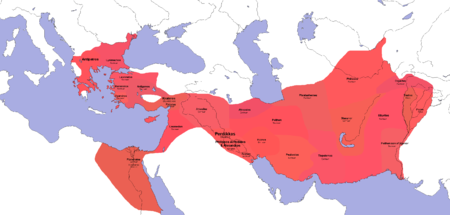آتروپات
آتروپات ( Atropates ؛ الفارسية القديمة: *Ātr̥pātah والفارسية الوسيطة Ātūrpāt;[1] باليونانية قديمة: Ἀτροπάτης Atropátēs; c. 370 BC – after 321 BC) was a Persian[2] nobleman who served Darius III, then Alexander the Great, and eventually founded an independent kingdom and dynasty that was named after him. Diodorus (18.4) refers to him as Atrápēs (Ἀτράπης),[3] while Quintus Curtius (8.3.17) erroneously names him 'Arsaces'.
السيرة
Towards the end of the Achaemenid Empire, Atropates was governor (satrap) of the Achaemenid province of ميديا. In the decisive Battle of Gaugamela (October 331 BCE) between Darius and Alexander, Atropates commanded the Achaemenid troops of Media and Sacasene.
Following his defeat in that battle, Darius fled to the Median capital of Ecbatana, where Atropates gave him hospitality. Darius attempted to raise a new army but was forced to flee Ecbatana in June 330 BCE. After Darius' death a month later at the hands of Bessus, Atropates surrendered to Alexander.[4] Alexander initially chose Oxydates as satrap of Media, but in 328-327 BCE after a period of two years Alexander lost trust in Oxydates' loyalty, and Atropates was reinstated to his old position.[5] In 325-324, Atropates delivered Baryaxes (a sought-after rebel of the region) to Alexander while the latter was at Pasargadae. Alexander's esteem for the governor rose so high that soon afterwards Atropates' daughter was married to Alexander's confidant and cavalry commander Perdiccas at the famous mass wedding at Susa in February 324 BCE.[4]
Later that year, Alexander visited Atropates in Ecbatana with his good friend and second-in-command Hephaestion, who fell ill and died in October 324 BCE. At this time, "[i]t was related by some authors, that Atropates on one occasion presented Alexander with a hundred women, said to be Amazons; but Arrian ([Anabasis] vii. 13) disbelieved the story."[6]
Alexander himself died eight months later on June 10, 323 BCE, and Atropates' new son-in-law Perdiccas was named regent of Alexander's half-brother Philip III. Following the "Partition of Babylon" in 323 BCE, Media was divided into two parts: the greater portion in the south-east was to be governed by Peithon, a general of Perdiccas, while a smaller portion in the north west (principally around the Araxes River basin) was given to Atropates. At some point thereafter, Atropates refused to convey allegiance to the diadochi and made his part of Media an independent kingdom, while his son-in-law Perdiccas was eventually murdered by Peithon in the summer of 320 BCE.
الذكرى
The dynasty Atropates founded would rule the kingdom for several centuries, at first either independently أو كتابع للسلوقيين, then as vassals of the Arsacids, into whose house they are said[7] to have married.
The region that encompassed Atropates' kingdom come to be known to the Greeks as "Media Atropatene" after Atropates, and eventually simply "Atropatene". The Arsacids called it 'Aturpatakan' in Parthian, as did also the Sassanids who eventually succeeded them. Eventually, Middle Iranian Āturpātakān became Āzarbāygān and Āzarbāyjān in New Persian, whence the names of the modern nation of Azerbaijan and the Iranian region of Azerbaijan (which is largely contiguous with the borders of ancient Atropatene).[8][7] Medieval Arab geographers came up with other explanations of the name, such as 'fire temple' or 'guardian of the fire', from the Persian words āzar 'fire', and pāyegān 'guardian/protector'.[9]
المراجع
- ^ Tavernier 2007, pp. 125.
- ^ Fredricksmeyer 2002, p. 92; Schippmann 1987, pp. 221–224; Roisman 2002, p. 187
- ^ Diodorus Siculus. "3". Βιβλιοθήκη Ἱστορική [Historical Library] (in اليونانية القديمة). Vol. 18.
- ^ أ ب Chaumont 1987, pp. 17–18.
- ^ Roisman 2002, p. 189.
- ^ Smith, William, ed. (1867), "Atropates", Dictionary of Greek and Roman Biography and Mythology, Boston
- ^ أ ب Schippmann 1987, pp. 221–224.
- ^ Streck (1993). "Ād̲h̲arbaid̲j̲ān". In Houtsma, M. Th. (ed.). First Encyclopaedia of Islam 1913–1936 (reprint ed.). BRILL. ISBN 978-90-04-09796-4.
- ^ de Planhol 1987, pp. 205–215.
ببليزگرافيا
الأعمال القديمة
- Justin, Epitome of the Philippic History of Pompeius Trogus.
- Strabo, Geographica.
الأعمال الحديثة
- Boyce, Mary (2000). "Ganzak". In Yarshater, Ehsan (ed.). Encyclopædia Iranica, Volume X/3: Fruit–Gāvbāzī. London and New York: Routledge & Kegan Paul. pp. 289–290. ISBN 978-0-933273-47-4.
- Chaumont, M. L. (1987). "Atropates". In Yarshater, Ehsan (ed.). Encyclopædia Iranica, Volume III/1: Ātaš–Awāʾel al-Maqālāt. London and New York: Routledge & Kegan Paul. pp. 17–18. ISBN 978-0-71009-113-0.
- Fredricksmeyer, Ernst (2002). Bosworth, A. B.; Baynham, E. J. (eds.). Alexander the Great and the Kingship of Asia. Alexander the Great in Fact and Fiction: Oxford University Press. pp. 1–370. ISBN 9780199252756.
- de Planhol, X. (1987). "Azerbaijan i. Geography". In Yarshater, Ehsan (ed.). Encyclopædia Iranica, Volume III/2: Awāʾel al-maqālāt–Azerbaijan IV. London and New York: Routledge & Kegan Paul. pp. 205–215. ISBN 978-0-71009-114-7.
- Schippmann, K. (1987). "Azerbaijan iii. Pre-Islamic History". In Yarshater, Ehsan (ed.). Encyclopædia Iranica, Volume III/2: Awāʾel al-maqālāt–Azerbaijan IV. London and New York: Routledge & Kegan Paul. pp. 221–224. ISBN 978-0-71009-114-7.
- Roisman, Joseph (2002). Brill's Companion to Alexander the Great. London and New York: Edinburgh University Press. pp. 1–436. ISBN 9789004217553.
- Tavernier, Jan (2007). Iranica in the Achaemenid Period (ca. 550-330 B.C.): Lexicon of Old Iranian Proper Names and Loanwords, Attested in Non-Iranian Texts. Peeters Publishers. ISBN 9789042918337.
- CS1 foreign language sources (ISO 639-2)
- Articles containing فارسية قديمة (ح. 600-400 ق.م.)-language text
- Articles containing Ancient Greek (to 1453)-language text
- Satraps of the Alexandrian Empire
- Achaemenid satraps of Media
- حكام أتوروپاتكان
- ملوك القرن الرابع ق.م.
- Ancient Persian people
- إيرانيو القرن الرابع ق.م.
- Darius III
- أتوروپاتكان

